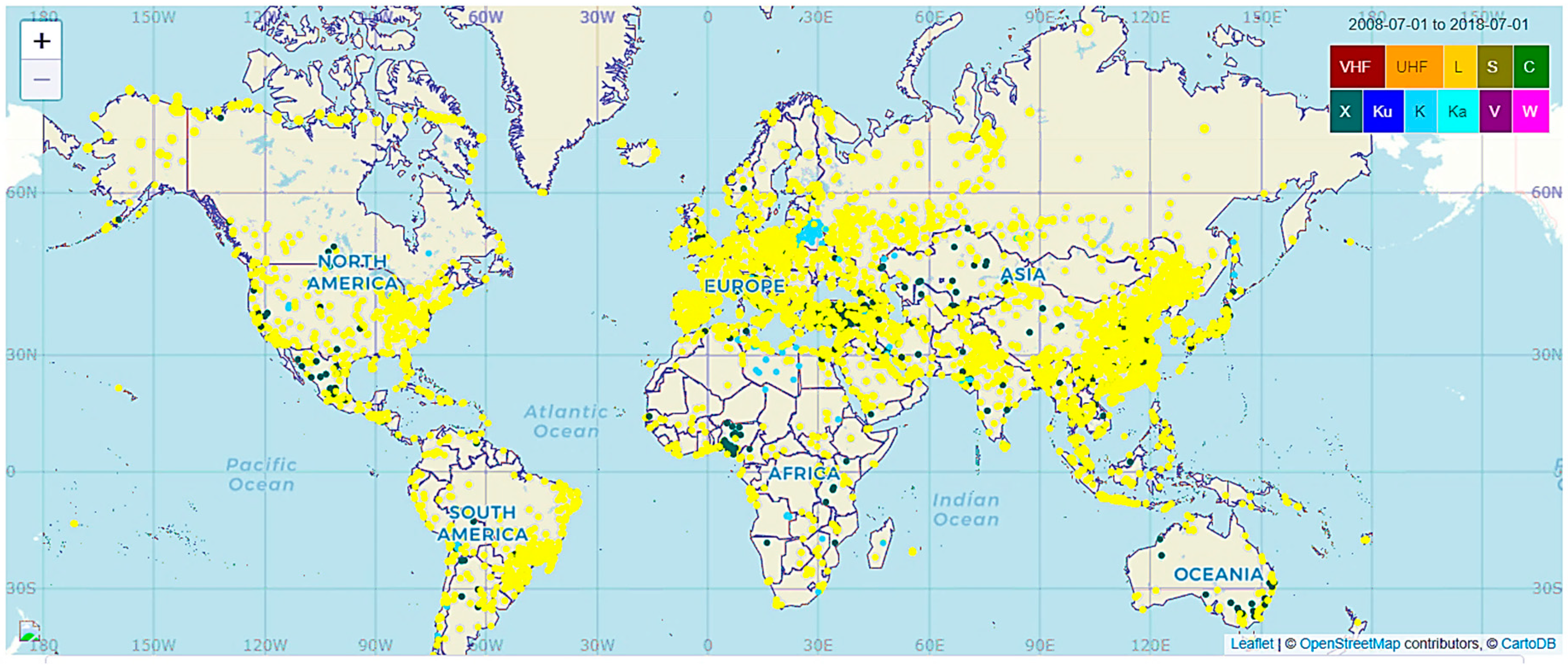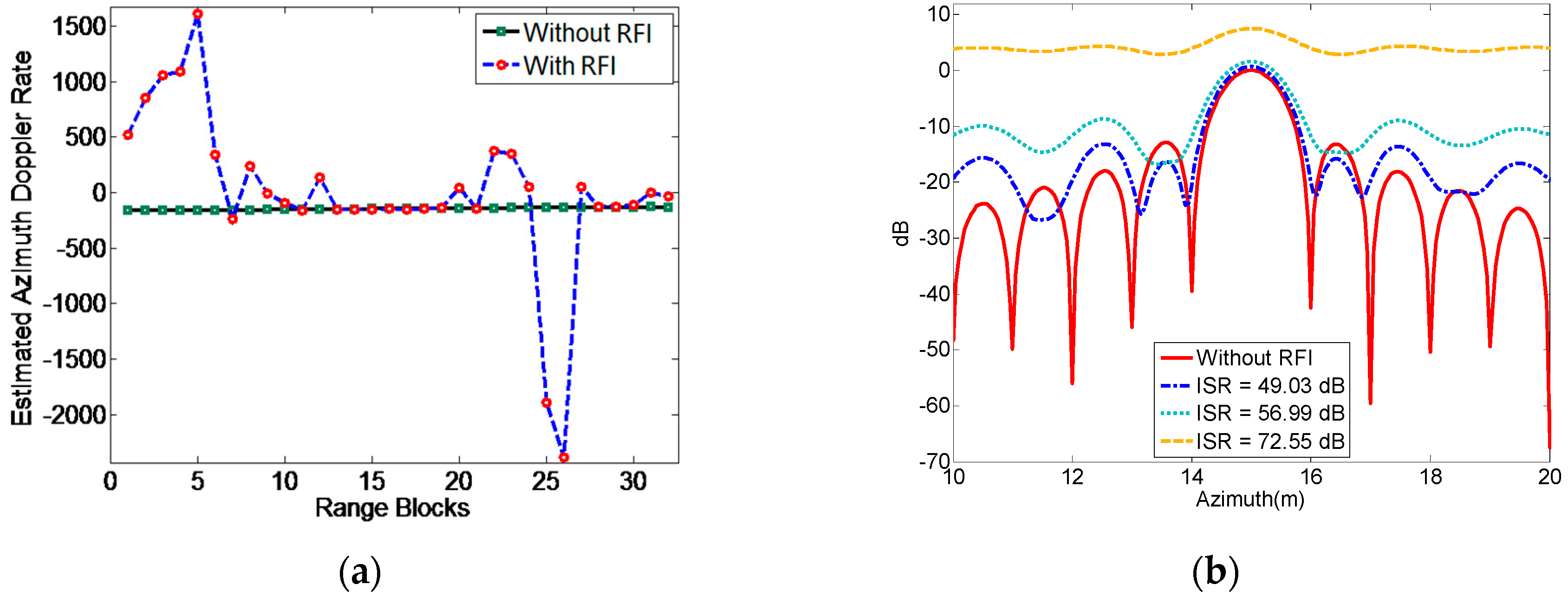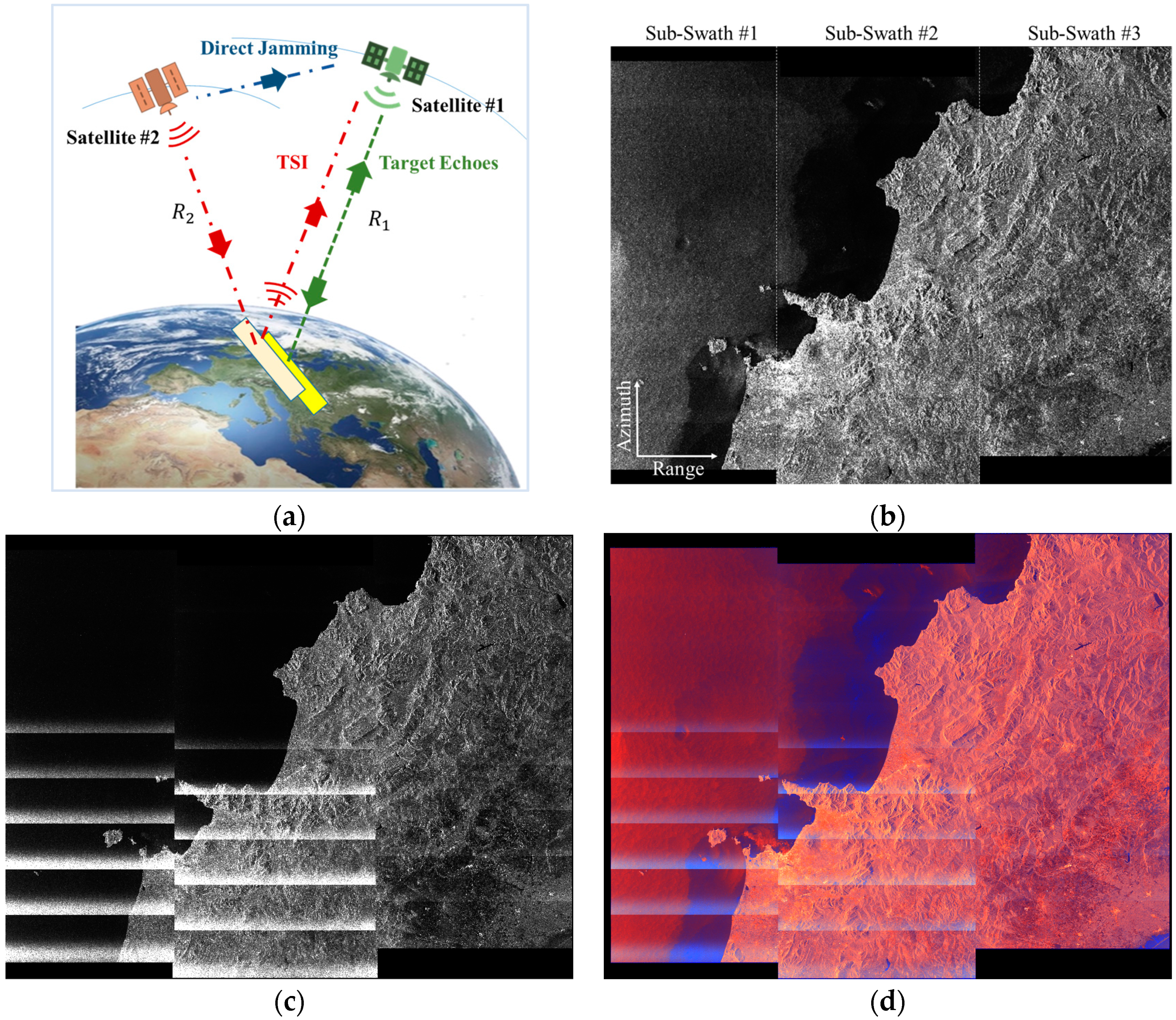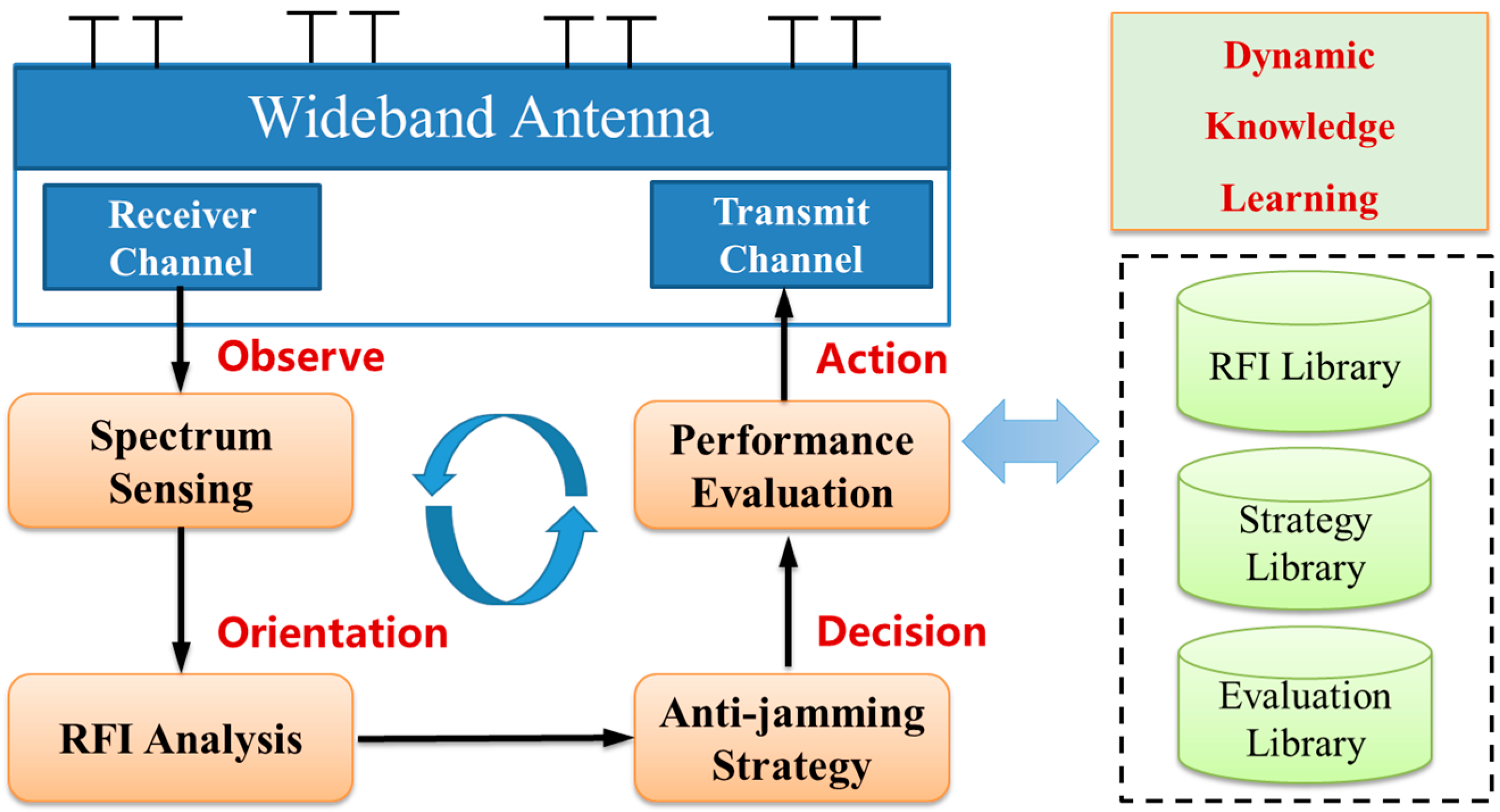Mitigation of Radio Frequency Interference in Synthetic Aperture Radar Data: Current Status and Future Trends
Abstract
:1. Introduction
1.1. Congested Electromagnetic Environment
1.2. Advese Impacts of RFI to SAR System
1.2.1. Data Collection Process
1.2.2. Image Formation Process
1.2.3. Image Interpretation Process
1.3. Objective and Organization of This Paper
2. Interfering Mechanism and Major RFI Sources
2.1. Frequency Allocation and Regulation
2.2. Terrestrial RFI Sources
2.3. Space-Borne RFI Sources
2.4. General Signal Model for Typical RFI Sources
3. Mitigation Scheme for SAR
3.1. Notch Filtering
3.2. Estimation and Subtraction
3.3. Adaptive Filtering
3.3.1. Recursive Filter
3.3.2. Time–Frequency Filtering
3.3.3. Spatial Filtering
3.4. Decomposition and Reconstruction
3.4.1. Decomposition
3.4.2. Reconstruction
3.5. Discussions
- System architecture of the SAR instrument: if SAR has multiple antennas, the sniffing pulse and spatial filtering could be employed. If not, only other signal processing techniques can be applied.
- Configuration or mode for a particular observation: the scanning mode of the data acquisition like stripmap mode, spotlight mode, scan mode, etc., defines the interfering geometry, which determines whether the RFI directs into the SAR receiver from the terrestrial RFI sources or scattered by multi-path from spaceborne RFI sources (as discussed in Section 2.2 and Section 2.3). Different observed modes will lead to different ISR, which is a key factor affecting the algorithm performance.
- Nature of the RFI: for example, whether the RFI source is persistent or intermittent emitted, whether the bandwidth, polarization type is temporally or spatially correlated with the transmitted signal of SAR system, as discussed in Section 2.4.
- The availability of computational resources.
4. Suggestions for Future Trends
4.1. Cognitive
4.2. Integrated
4.3. Adaptive
5. Conclusions
Author Contributions
Funding
Conflicts of Interest
References
- National Academies of Sciences, Engineering, and Medicine. A Strategy for Active Remote Sensing Amid Increased Demand for Radio Spectrum; National Academies Press: Washington, DC, USA, 2015. [Google Scholar]
- Spencer, M.; Ulaby, F. Spectrum issues faced by active remote sensing. IEEE Geosci. Remote Sens. Mag. 2016, 4, 40–45. [Google Scholar] [CrossRef]
- De Matthaeis, P.; Oliva, R.; Soldo, Y. Spectrum management and its importance for microwave remote sensing. IEEE Geosci. Remote Sens. Mag. 2018, 6, 17–25. [Google Scholar] [CrossRef]
- IEEE FARS Technical Committee. Database of Frequency Allocations for Microwave Remote Sensing and Observed Radio Frequency Interference. Available online: http://grss-ieee.org/microwave-interferers/ (accessed on 13 August 2019).
- Tao, M.; Zhou, F.; Zhang, Z. Characterization and Mitigation of Radio Frequency Interference in PolSAR Data. Radio Sci. 2017, 52, 1405–1418. [Google Scholar] [CrossRef]
- NTIA Report TR-06-444. Effects of RF Interference on Radar Receivers. 2006. Available online: https://its.bldrdoc.gov/publications/details.aspx?pub=2481 (accessed on 30 June 2019).
- Zhang, L.; Qiao, Z.; Xing, M.; Yang, L.; Bao, Z. A robust motion compensation approach for UAV SAR imagery. IEEE Trans. Geosci. Remote Sens. 2012, 50, 3202–3218. [Google Scholar] [CrossRef]
- Tao, M.; Zhou, F.; Zhang, Z. Wideband Interference Mitigation in High-Resolution Airborne Synthetic Aperture Radar Data. IEEE Trans. Geosci. Remote. Sens. 2015, 54, 74–87. [Google Scholar] [CrossRef]
- Xu, H.; Wu, Z.; Liu, W.; Li, J.; Feng, Q. Analysis of the effect of interference on InSAR. IEEE Sens. J. 2015, 15, 5659–5668. [Google Scholar] [CrossRef]
- Spencer, M.W.; Chen, C.W.; Ghaemi, H.; Chan, S.F.; Belz, J.E. RFI characterization and mitigation for the SMAP radar. IEEE Trans. Geosci. Remote Sens. 2013, 51, 4973–4982. [Google Scholar] [CrossRef]
- Doerry, A.W. Comments on radar interference sources and mitigation techniques. In Proceedings of the SPIE 2015 Defense & Security Symposium, Baltimore, MD, USA, 20 April 2015; pp. 1–8. [Google Scholar]
- Nguyen, L.H.; Tran, T.D. A comprehensive performance comparison of RFI mitigation techniques for UWB radar signals. In Proceedings of the International Conference on Acoustics, Speech, and Signal Process, New Orleans, LA, USA, 5–9 March 2017; pp. 3086–3090. [Google Scholar]
- Griffiths, H.; Cohen, L.; Watts, S.; Mokole, E.; Baker, C.; Wicks, M.; Blunt, S. Radar spectrum engineering and management: Technical and regulatory issues. Proc. IEEE 2015, 108, 85–102. [Google Scholar] [CrossRef]
- Misra, S.; de Matthaeis, P. Passive remote sensing and radio frequency interference (RFI): An overview of spectrum allocations and RFI management algorithms. IEEE Geosci. Remote Sens. Mag. 2014, 2, 68–73. [Google Scholar] [CrossRef]
- ITU-R Recommendation RS.577-7. Frequency Bands and Required Bandwidths Used for Spaceborne Active Sensors Operating in the Earth Exploration-Satellite (Active) and Space Research (Active) Services. 2009. Available online: https://www.itu.int/rec/R-REC1-RS.577/en (accessed on 30 June 2019).
- National Academies of Sciences, Engineering, and Medicine. Spectrum Management for Science in the 21st Century; The National Academies Press: Washington, DC, USA, 2010. [Google Scholar]
- Committee on Scientific Use of the Radio Spectrum. Handbook of Frequency Allocations and Spectrum Protection for Scientific Uses, 2nd ed.; The National Academies Press: Washington, DC, USA, 2015. [Google Scholar]
- Le, C.; Hensley, S.; Chapin, E. Adaptive Filtering of RFI in Wideband Radars Using the LMS Algorithms. Part I: The TDLMS Adaptive Filter. 1998. Available online: http://citeseerx.ist.psu.edu/viewdoc/summary?doi=10.1.1.596.393 (accessed on 18 October 2019).
- Le, C.; Hensley, S. RFI Removal from AirSAR Polarimetric Data; In Proceedings of the JPL AIRSAR Workshop, Pasadena, California, USA, 4–6 March 2002; pp. 1–4. [Google Scholar]
- Buckreuss, S.; Horn, R. E-SAR P-band SAR subsystem design and RF-Interference suppression. In Proceedings of the IEEE International Geoscience Remote Sensing Symposium, Seattle, WA, USA, 6–10 July 1998; pp. 1–4. [Google Scholar]
- Meyer, F.J.; Nicoll, J.B.; Doulgeris, A.P. Correction and characterization of radio frequency interference signatures in L-band synthetic aperture radar data. IEEE Trans. Geosci. Remote Sens. 2013, 51, 4961–4972. [Google Scholar] [CrossRef]
- Natsuaki, R.; Motohka, T.; Tadono, T.; Suzuki, S. Polarimetric characteristics of temporarily coherent RFI in ALOS-2 PALSAR-2. In Proceedings of the IEEE International Geoscience Remote Sensing Symposium, Fortworth, TX, USA, 23–28 July 2017; pp. 3155–3158. [Google Scholar]
- Monti-Guarnieri, A.; Giudici, D.; Recchia, A. Identification of C-Band Radio Frequency Interferences from Sentinel-1 Data. Remote Sens. 2017, 9, 1183. [Google Scholar] [CrossRef]
- Leng, X.; Ji, K.; Zhou, S.; Xing, X.; Zou, H. Discriminating Ship from Radio Frequency Interference Based on Noncircularity and Non-Gaussianity in Sentinel-1 SAR Imagery. IEEE Trans. Geosci. Remote Sens. 2019, 57, 352–363. [Google Scholar] [CrossRef]
- Recchia, A.; Giudici, D.; Piantanida, R.; Franceschi, N.; Monti-Guarnieri, A.; Miranda, N. On the effective usage of Sentinel-1 noise pulses for denoising and RFI identification. In Proceedings of the 12th European Conference on Synthetic Aperture Radar, Aachen, Germany, 4–7 June 2018; pp. 1–4. [Google Scholar]
- Li, Y.; Guarnieri, A.M.; Hu, C.; Rocca, F. Performance and requirements of GEO SAR systems in the presence of radio frequency interferences. Remote Sens. 2018, 10, 82. [Google Scholar] [CrossRef]
- Santamaria, C.; Alvarez, M.; Greidanus, H.; Syrris, V.; Soille, P.; Argentieri, P. Mass Processing of Sentinel-1 Images for Maritime Surveillance. Remote. Sens. 2017, 9, 678. [Google Scholar] [CrossRef]
- S-1 Mission Performance Center. Sentinel-1 Long Duration Mutual Interference. 2018. Available online: http://sentinel.esa.int/documents/247904/2142675/ (accessed on 30 June 2019).
- Leanza, A.; Manzoni, M.; Monti-Guarnieri, A.; Di Clemente, M. LEO to GEO-SAR Interferences: Modelling and Performance Evaluation. Remote. Sens. 2019, 11, 1720. [Google Scholar] [CrossRef]
- Reigber, A.; Ferro-Famil, L. Interference suppression in synthesized SAR images. IEEE Geosci. Remote Sens. Lett. 2005, 2, 45–49. [Google Scholar] [CrossRef]
- Yang, L.; Zheng, H.; Feng, J.; Li, N.; Chen, J. Detection and suppression of narrow band RFI for synthetic aperture radar imaging. Chin. J. Aeronaut. 2015, 28, 1189–1198. [Google Scholar] [CrossRef] [Green Version]
- Zhao, T.; Zhang, Y.; Yang, L.; Dong, Z.; Liang, D. The RFI suppression method based on STFT applied to SAR. Prog. Electromagn. Res. M 2013, 31, 171–188. [Google Scholar] [CrossRef]
- ITU-R Recommendation RS.1749. Mitigation Technique to Facilitate the Use of the 1 215-1 300 MHz Band by the Earth Exploration-Satellite Service (Active) and the Space Research Service (Active). 2006. Available online: https://www.itu.int/rec/R-REC-RS.1749/en (accessed on 30 June 2019).
- Feng, J.; Zheng, H.; Deng, Y.; Gao, D. Application of subband spectral cancellation for SAR narrow-band interference suppression. IEEE Geosci. Remote Sens. Lett. 2012, 9, 190–193. [Google Scholar] [CrossRef]
- Doerry, A.W. Apodized RFI Filtering of Synthetic Aperture Radar Images; Sandia National Laboratories: Albuquerque, NM, USA, 2014. [Google Scholar]
- Natsuaki, R.; Motohka, T.; Watanabe, M.; Shimada, M. An autocorrelation-based radio frequency interference detection and removal method in azimuth-frequency domain for SAR image. IEEE J. Sel. Top. Appl. Earth Obs. 2017, 10, 5736–5751. [Google Scholar] [CrossRef]
- Davis, M. Frequency allocation challenges for ultra-wideband radars. IEEE Aerosp. Electron. Syst. Mag. 2013, 28, 12–18. [Google Scholar] [CrossRef]
- Pinheiro, M.; Rodrigues-Cassola, M.; Prats-Iraoloa, P.; Reigber, A.; Krieger, G.; Moreira, A. Reconstruction of coherent pairs of synthetic aperture radar data acquired in interrupted mode. IEEE Trans. Geosci. Remote Sens. 2015, 53, 1876–1893. [Google Scholar] [CrossRef]
- Musgrove, C.; West, J.C. Application of equalization notch to improve synthetic aperture radar coherent data products. Proc. SPIE 2015, 9461, 94610. [Google Scholar]
- Musgrov, C.; West, J.C. Mitigating effects of missing data for SAR coherent images. IEEE Trans. Aerosp. Electron. Syst. 2017, 53, 716–721. [Google Scholar] [CrossRef]
- Musgrov, C.; West, J.C. Replacing missing data between airborne SAR coherent image pairs. IEEE Trans. Aerosp. Electron. Syst. 2017, 53, 3150–3158. [Google Scholar] [CrossRef]
- Nguyen, L.; Soumekh, M. Suppression of radio frequency interference (RFI) for synchronous impulse reconstruction ultra-wideband radar. Proc. SPIE 2005, 5808, 178–184. [Google Scholar]
- Miller, T.R. Radio frequency interference suppression for foliage penetrating radar imaging. Ph.D. Thesis, Ohio State University, Columbus, OH, USA, 1994. [Google Scholar]
- Yi, J.; Wan, X.; Cheng, F.; Gong, Z. Computationally efficient RF interference suppression method with closed-form maximum likelihood estimator for HF surface wave over-the-horizon radars. IEEE Trans. Geosci. Remote Sens. 2013, 51, 2361–2372. [Google Scholar] [CrossRef]
- Ojowu, O., Jr.; Li, J. RFI suppression for synchronous impulse reconstruction UWB radar using RELAX. Int. J. Remote Sens. Appl. 2013, 3, 33–46. [Google Scholar]
- Cazzaniga, G.; Guarnieri, A.M. Removing RF interferences from P-band airplane SAR data. In Proceedings of the 1996 International Geoscience and Remote Sensing Symposium, Lincoln, NE, USA, 31 May 1996; pp. 1–4. [Google Scholar]
- Miller, T.; Potter, L.; McCorkle, J. RFI suppression for ultra wideband radar. IEEE Trans. Aerosp. Electron. Syst. 1997, 33, 1142–1156. [Google Scholar] [CrossRef]
- Lord, R.T. Radio Frequency Interference Suppression Applied to Synthetic Aperture Radar Data. In Proceedings of the XXVIIIth General Assembly of International Union of Radio Science, New Delhi, India, 23–29 October 2005; pp. 1–4. [Google Scholar]
- Potsis, A.; Uzunoglou, N.; Frangos, P.; Horn, R.; Lamprecht, K. Analysis of P-Band Synthetic Aperture Radar for Airborne and Spaceborne Applications. 2000. Available online: https://apps.dtic.mil/dtic/tr/fulltext/u2/p010835.pdf (accessed on 18 October 2019).
- Potsis, A.; Reigber, A.; Papathanassiou, K.P. A phase preserving method for RF interference suppression in P-bannd synthetic aperture radar interferometric data. In Proceedings of the IEEE 1999 International Geoscience and Remote Sensing Symposium, Hamburg, Germany, 28 June–2 July 1999; pp. 1–4. [Google Scholar]
- Lord, R.T.; Inggs, M.R. Efficient RFI suppression in SAR using LMS adaptive filter integrated with range/Doppler algorithm. Electron. Lett. 1999, 35, 629–630. [Google Scholar] [CrossRef]
- Rosen, P.A.; Hensly, S.; Le, C. Observations and mitigation of RFI in ALOS PALSAR SAR data: Implications for the DESDYNI mission. In Proceedings of the IEEE Radar Conference, Rome, Italy, 26–30 May 2008; pp. 1–4. [Google Scholar]
- Luo, X.; Ulander, L.; Askne, J.; Smith, G.; Frölind, P.-O. RFI suppression in ultra-wideband SAR systems using LMS filters in frequency domain. Electron. Lett. 2001, 37, 241–243. [Google Scholar] [CrossRef]
- Harcke, L.J.; Le, C.T. AirMoss P-band RF interference experience. In Proceedings of the IEEE Radar Conference, Cincinnati, OH, USA, 19–23 May 2014; pp. 1–4. [Google Scholar]
- Vu, V.T.; Sjogren, T.K.; Gustavsson, M.I.P.L.H.A.; Ulander, L. RFI suppression in ultrawideband SAR using an adaptive line enhancer. IEEE Geosci. Remote Sens. Lett. 2010, 7, 694–698. [Google Scholar] [CrossRef]
- Li, Y.; Li, X.; Zhou, Z. Side-lobe reduction for radio frequency interference suppression via clipping of strong scatterers. IEEE Geosci. Remote Sens. Lett. 2016, 13, 1178–1182. [Google Scholar] [CrossRef]
- Lamont-Smith, T.; Hill, R.D.; Hayward, S.; Yates, G.; Blake, A. Filtering approaches for interference suppression in low-frequency SAR. IET Radar Sonar and Navig. 2016, 153, 338–344. [Google Scholar] [CrossRef]
- Song, Y.; Hu, J.; Dai, Y.; Jin, T.; Zhou, Z. Estimation and mitigation of time-variant RFI in low-frequency ultra-wideband radar. IEEE Geosci. Remote Sens. Lett. 2018, 15, 409–413. [Google Scholar] [CrossRef]
- Zhang, S.; Xing, M.; Guo, R.; Zhang, L.; Bao, Z. Interference Suppression Algorithm for SAR Based on Time–Frequency Transform. IEEE Trans. Geosci. Remote. Sens. 2011, 49, 3765–3779. [Google Scholar] [CrossRef]
- Li, D.; Liu, H.; Yang, L. Efficient time-varying interference suppression method for synthetic aperture radar imaging based on time-frequency reconstruction and mask technique. IET Radar Sonar Navig. 2015, 9, 827–834. [Google Scholar] [CrossRef]
- Liu, Z.; Liao, G.; Yang, Z. Time variant RFI suppression for SAR using iterative adaptive approach. IEEE Geosci. Remote Sens. Lett. 2013, 10, 1424–1428. [Google Scholar] [CrossRef]
- Yang, Z.; Du, W.; Liu, Z.; Liao, G. WBI suppression for SAR using iterative adaptive method. IEEE J. Sel. Topics Appl. Earth Obs. Remote Sens. 2016, 9, 1008–1014. [Google Scholar] [CrossRef]
- Su, J.; Tao, H.; Tao, M. Time-varying SAR interference suppression based on delay-Doppler iterative decomposition algorithm. Remote Sens. 2018, 10, 1491. [Google Scholar] [CrossRef]
- Rosenberg, L.; Gray, D.A. Anti-jamming techniques for multichannel SAR imaging. IET Radar Sonar Navig. 2006, 153, 234–242. [Google Scholar] [CrossRef] [Green Version]
- Rosenberg, L. Multichannel Synthetic Aperture Radar. Ph.D. Thesis, School of Electrical & Electronic Engineering, University of Adelaide, Adelaide, Australia, 2007. [Google Scholar]
- Rosenberg, L.; Gray, D.A. Constrained Fast-Time STAP for interference suppression in multichannel SAR. IEEE Trans. Aerosp. Electron. Syst. 2013, 49, 1792–1805. [Google Scholar] [CrossRef]
- Osmanoglu, B.; Rincon, R.F.; Lee, S.; Fatoyinbo, T.; Bollian, T. Radio frequency interference detection and mitigation techniques using data from EcoSAR 2014 flight campaign. In Proceedings of the EUSAR 2016: 11th European Conference on Synthetic Aperture Radar, Hamburg, Germany, 6–9 June 2016; pp. 1–4. [Google Scholar]
- Bollian, T.; Osmango, B.; Rincon, R.F.; Lee, S.; Fatoyinbo, T.E. Detection and geolocation of P-band radio frequency interference using EcoSAR. IEEE J. Sel. Topics Appl. Earth Obs. Remote Sens. 2017, 11, 3608–3616. [Google Scholar] [CrossRef]
- Bollian, T.; Osmanoglu, B.; Rincon, R.; Lee, S.-K.; Fatoyinbo, T. Adaptive Antenna Pattern Notching of Interference in Synthetic Aperture Radar Data Using Digital Beamforming. Remote. Sens. 2019, 11, 1346. [Google Scholar] [CrossRef]
- Zhou, F.; Tao, M. Research on Methods for Narrow-Band Interference Suppression in Synthetic Aperture Radar Data. IEEE J. Sel. Top. Appl. Earth Obs. Remote. Sens. 2015, 8, 3476–3485. [Google Scholar] [CrossRef]
- Zhou, F.; Wu, R.; Xing, M.; Bao, Z. Eigen subspace-based filtering with application in narrowband interference suppression for SAR. IEEE Geosci. Remote Sens. Lett. 2007, 4, 75–79. [Google Scholar] [CrossRef]
- Zhou, F.; Tao, M.; Bai, X.; Liu, J. Narrow-band interference suppression for SAR based on independent component analysis. IEEE Trans. Geosci. Remote Sens. 2015, 51, 4952–4960. [Google Scholar] [CrossRef]
- Tao, M.; Zhou, F.; Liu, J.; Liu, Y.; Zhang, Z.; Zhang, Z.; Bao, Z. Narrow-band interference mitigation for SAR using independent subspace analysis. IEEE Trans. Geosci. Remote Sens. 2014, 52, 5289–5301. [Google Scholar]
- Zhou, F.; Xing, M.; Bai, X.; Sun, G.; Bao, Z. Narrowband interference suppression for SAR based on complex empirical mode decomposition. IEEE Geosci. Remote Sens. Lett. 2009, 6, 423–427. [Google Scholar] [CrossRef]
- Elgamel, S.; Soraghan, J. Using EMD-FrFT filtering to mitigate very high power interference in chirp tracking radars. IEEE Signal Proc. Lett. 2011, 18, 263–266. [Google Scholar] [CrossRef]
- Liu, H.; Li, D.; Zhou, Y.; Truong, T.K. Joint wideband interference suppression and SAR signal recovery based on sparse representations. IEEE Geosci. Remote Sens. Lett. 2017, 14, 1542–1546. [Google Scholar] [CrossRef]
- Liu, H.; Li, D. RFI suppression based on sparse frequency estimation for SAR imaging. IEEE Geosci. Remote Sens. Lett. 2016, 13, 63–67. [Google Scholar] [CrossRef]
- Liu, H.; Li, D.; Zhou, Y.; Truong, T. Simultaneous radio frequency and wideband interference suppression in SAR signals via sparsity exploitation in time-frequency domain. IEEE Trans. Geosci. Remote Sens. 2018, 56, 5780–5793. [Google Scholar] [CrossRef]
- Nguyen, L.; Tran, T.; Do, T. Sparse models and sparse recovery for ultra-wideband SAR applications. IEEE Trans. Aerosp. Electron. Syst. 2014, 50, 940–958. [Google Scholar] [CrossRef]
- Lu, X.; Yang, J.; Ma, C.; Gu, H.; Su, W. Wide-band interference mitigation algorithm for SAR based on time-varying filtering and sparse recovery. Electron. Lett. 2018, 54, 165–167. [Google Scholar] [CrossRef]
- Su, J.; Tao, H.; Tao, M.; Wang, L.; Xie, J. Narrow-band interference suppression via RPCA-based signal separation in time-frequency domain. IEEE J. Sel. Topics Appl. Earth Earth Obs. Remote Sens. 2017, 10, 5016–5025. [Google Scholar] [CrossRef]
- Nguyen, L.; Tran, T. Efficient and robust RFI extraction via sparse recovery. IEEE J. Sel. Topics Appl. Earth Earth Obs. Remote Sens. 2016, 9, 2104–2117. [Google Scholar] [CrossRef]
- Nguyen, L.; Dao, M.; Tran, T. Joint sparse and low-rank model for radio-frequency interference Suppression in ultra-wideband radar applications. In Proceedings of the 48th Asilomar Conference on Signals, Systems and Computers, Pacific Grove, CA, USA, 2–5 November 2014; pp. 1–4. [Google Scholar]
- Joy, S.; Nguyen, L.; Tran, T. Radio frequency interference suppression in ultra-wideband synthetic aperture radar using range-azimuth sparse and low-rank model. In Proceedings of the 2016 IEEE Radar Conference (RadarConf), Philadelphia, PA, USA, 2–6 May 2016; pp. 1–4. [Google Scholar]
- Nguyen, L.; Tran, T. RFI-radar signal separation via simultaneous low-rank and sparse recovery. In Proceedings of the 2016 IEEE Radar Conference (RadarConf), Philadelphia, PA, USA, 2–6 May 2016; pp. 1–4. [Google Scholar]
- Huang, Y.; Liao, G.; Li, J.; Xu, J. Narrowband RFI suppression for SAR system via fast implementation of joint sparsity and low-rank property. IEEE Trans. Geosci. Remote Sens. 2018, 56, 2748–2761. [Google Scholar] [CrossRef]
- Huang, Y.; Liao, G.; Zhang, Z.; Xiang, Y.; Li, J.; Nehorai, A. Fast narrowband RFI suppression algorithms for SAR systems via matrix-factorization techniques. IEEE Trans. Geosci. Remote Sens. 2019, 57, 250–262. [Google Scholar] [CrossRef]
- Huang, Y.; Liao, G.; Zhang, Z.; Xiang, Y.; Li, J. Narrowband RFI Suppression for SAR system via efficient parameter-free decomposition algorithm. IEEE Trans. Geosci. Remote Sens. 2018, 56, 3311–3322. [Google Scholar] [CrossRef]
- Ren, J.; Zhang, T.; Li, J.; Nguyen, L.H.; Stoica, P. RFI mitigation for UWB radar via hyperparameter-free sparse SPICE methods. IEEE Trans. Geosci. Remote Sens. 2019, 57, 3105–3118. [Google Scholar] [CrossRef]
- Lu, X.; Su, W.; Yang, J.; Gu, H.; Zhang, H.; Yu, W.; Yeo, T. Radio frequency interference suppression for SAR via block sparse Bayesian learning. IEEE J. Sel. Topics Appl. Earth Earth Obs. Remote Sens. 2018, 11, 4835–4847. [Google Scholar] [CrossRef]
- Li, G.; Ye, W.; Lao, G.; Kong, S.; Yan, D. Narrowband interference separation for synthetic aperture radar via sensing matrix optimization-based block sparse Bayesian learning. Electronics 2019, 8, 458. [Google Scholar] [CrossRef]
- Stinco, P.; Greco, M.; Gini, F.; Himed, B. Cognitive radars in spectrally dense environments. IEEE Aerosp. Electron. Syst. Mag. 2016, 28, 12–18. [Google Scholar] [CrossRef]
- DARPA. Spectrum Collaboration Challenge. Available online: https://spectrumcollaborationchallenge.com/about/ (accessed on 30 June 2019).
- Scagliola, M.; Giudici, D.; Ramongassie, S.; Heliere, F.; Fois, F. Ground processing RFI mitigation strategy for Biomass: A feasibility study. In Proceedings of the 2015 IEEE International Geoscience and Remote Sensing Symposium (IGARSS), Milan, Italy, 26–31 July 2015; pp. 128–131. [Google Scholar]
- Prats-Iraola, P.; Papathanassiou, K.; Kim, J. The BIOMASS ground processor prototype: An overview. In Proceedings of the EUSAR 2018; 12th European Conference on Synthetic Aperture Radar, Aachen, Germany, 4–7 June 2018; pp. 919–924. [Google Scholar]
- Li, W.; Liang, D.; Dong, Z. Anti-jamming technique for distributed microsatellites SAR system. In Proceedings of the EuSAR 2006, Dresden, Germany, 16–18 May 2006; pp. 1–4. [Google Scholar]
- Wang, W.; Shao, H. Radar-to-radar interference suppression for distributed radar sensor networks. Remote Sens. 2014, 6, 740–755. [Google Scholar] [CrossRef]
- Krieger, G. MIMO-SAR: Opportunities and pitfalls. IEEE Trans. Geosci. Remote Sens. 2014, 52, 2628–2645. [Google Scholar] [CrossRef]
- Huang, Y. A Novel tensor technique for simultaneous narrowband and wideband interference suppression on single-channel SAR system. IEEE Trans. Geosci. Remote Sens. 2019, unpublished. [Google Scholar] [CrossRef]
- Tierney, C.; Mulgrew, B. Adaptive waveform design with least squares system identification for interference mitigation in SAR. In Proceedings of the 2017 IEEE Radar Conference (RadarConf), Seattle, WA, USA, 8–12 May 2017. [Google Scholar]
- Akeret, J.; Chang, C.; Lucchi, A.; Refregier, A. Radio frequency interference mitigation using deep convolutional neural networks. Astron. Comput. 2017, 18, 35–39. [Google Scholar] [CrossRef] [Green Version]
- Zhang, L.; You, W.; Wu, Q.M.; Qi, S.; Ji, Y. Deep learning-based automatic clutter/interference detection for HFSWR. Remote Sens. 2018, 10, 1517. [Google Scholar] [CrossRef]
- Yu, J.; Li, J.; Sun, B.; Chen, J.; Li, C. Multiclass radio frequency interference detection and suppression for SAR based on the single shot mutlibox detector. Sensors 2018, 11, 4034. [Google Scholar] [CrossRef] [PubMed]
- Fan, W.; Zhou, F.; Tao, M.; Bai, X.; Rong, P.; Yang, S.; Tian, T. Interference Mitigation for Synthetic Aperture Radar Based on Deep Residual Network. Remote. Sens. 2019, 11, 1654. [Google Scholar] [CrossRef]












| Band Designation | Allowable Frequency Interval | Permit Bandwidth |
|---|---|---|
| P band | 432–438 MHz | 6 MHz |
| L band | 1215–1300 MHz | 20–85 MHz |
| S band | 3100–3300 MHz | 20–200 MHz |
| C band | 5250–5570 MHz | 20–320 MHz |
| X band | 8550–8650 MHz | 20–100 MHz |
| 9300–9900 MHz | 20–300 MHz |
| Category | Literatures | Effective Against Signal Models in Section 2.4 | Pros | Cons | ||
|---|---|---|---|---|---|---|
| Narrow Band | Pulsed Wideband | Broadband CW | ||||
| Notch Filtering | Raw Data Range Spectrum Notching [20,21,33,34] | √ | × | × |
|
|
| Focused Image Notching [30,35,36,37] | √ | √ | × | |||
| Raw Data and Focused Image Notching [21] | √ | √ | × | |||
| Coherent Repairing Methods [38,39,40,41] | √ | √ | × |
|
| |
| Estimation and Subtraction | Parametric Modelling and Estimation [42,43,44,45,46,47,48] | √ | × | × |
|
|
| Adaptive Filtering | Least-mean-square Filter [18,19,49,50,51,52,53,54,55,56] | √ | × | × |
|
|
| Wiener filter [57,58] | √ | × | × | |||
| Time-frequency Filtering [8,32,59,60,61,62,63] | √ | √ | × |
|
| |
| Spatial Filtering [64,65,66,67,68,69] | √ | √ | √ |
|
| |
| Decomposition | Eigen-subspace Projection [70,71] | √ | × | × |
|
|
| Independent Component Analysis [72] | √ | × | × | |||
| Independent Subspace Analysis [73] | √ | √ | × | |||
| Complex Empirical Mode Decomposition [74,75] | √ | × | × | |||
| Reconstruction | Sparse Model [76,77,78,79,80] | √ | √ | × |
|
|
| Low Rank Model [81] | √ | × | × | |||
| Joint Sparsity and Low-Rank Models [82,83,84,85,86,87,88,89] | √ | √ | × | |||
| Block Sparse Bayesian Learning [90,91] | √ | √ | √ | |||
© 2019 by the authors. Licensee MDPI, Basel, Switzerland. This article is an open access article distributed under the terms and conditions of the Creative Commons Attribution (CC BY) license (http://creativecommons.org/licenses/by/4.0/).
Share and Cite
Tao, M.; Su, J.; Huang, Y.; Wang, L. Mitigation of Radio Frequency Interference in Synthetic Aperture Radar Data: Current Status and Future Trends. Remote Sens. 2019, 11, 2438. https://doi.org/10.3390/rs11202438
Tao M, Su J, Huang Y, Wang L. Mitigation of Radio Frequency Interference in Synthetic Aperture Radar Data: Current Status and Future Trends. Remote Sensing. 2019; 11(20):2438. https://doi.org/10.3390/rs11202438
Chicago/Turabian StyleTao, Mingliang, Jia Su, Yan Huang, and Ling Wang. 2019. "Mitigation of Radio Frequency Interference in Synthetic Aperture Radar Data: Current Status and Future Trends" Remote Sensing 11, no. 20: 2438. https://doi.org/10.3390/rs11202438
APA StyleTao, M., Su, J., Huang, Y., & Wang, L. (2019). Mitigation of Radio Frequency Interference in Synthetic Aperture Radar Data: Current Status and Future Trends. Remote Sensing, 11(20), 2438. https://doi.org/10.3390/rs11202438






